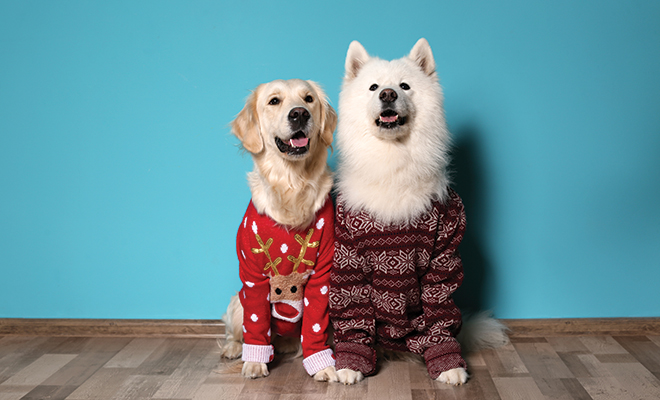
Fur Babies, It’s Cold Outside!
For many people across the nation, winter days mean bundling up and bracing for the cold and snow. The last few years have seen record-breaking days of harsh winter weather for many regions, with incredibly cold days due to polar vortexes and unusually large amounts of snow.
These conditions are challenging enough for humans; imagine how difficult it must be for our four-legged friends. Keeping our dogs and cats safe and healthy during cold days takes a little extra effort, but it’s still completely worth it.
Beyond Fur and Padding
There’s nothing like donning a warm fur coat to keep you cozy when winter winds blow. Cats and dogs are equipped with an extra layer of winter fur and they have tough padding on their feet for protection. Still, when the weather becomes severe, this may not be enough. Fur coats only go so far in keeping both humans and pets toasty warm during cold, damp or subzero weather, so limit outdoor exposure during those frigid, wet days.
Breeds that don’t have thick fur will need extra protection against the elements; luckily, pet stores are filled with adorable outerwear for pets. Smaller pooches will also appreciate a sweater or coat when temperatures take a nosedive. Cats, on the other hand, don’t tolerate mass-marketed clothing, so it’s best just to keep Kitty inside during severe cold months. Make sure your pet always wears a dry garment; wet coats and sweaters will make your pet colder.
Even though dogs have tough pads on their feet, those pads are prone to frostbite just like human skin. Many owners opt to protect their dog’s feet with adequately fitted and waterproof booties. Icy walkways, salt and other winter challenges can cause injury to your pet’s feet, and freezing snow can build up between your pup’s toes quickly.
Monitoring Health Issues
Pets can be prone to health issues, especially as they age. If your pet has problems such as arthritis or metabolic issues, it’s best to stay in since cold weather tends to aggravate those conditions. Vets recommend keeping puppies and older or sick pets inside rather than letting them brave the cold.
Arthritis can also cause mobility issues for your dog on ice or snow, which can make navigating slippery surfaces difficult for them. Unexpected slips and slides can result in sprains, strains and even dislocated hips in pets struggling with arthritic joints. Other diseases can make regulating body temperature difficult and increase the chances of breathing and lung issues. Owners should know that pets with hormonal imbalances, diabetes, heart or kidney disease will also struggle more during times of winter-like conditions and extreme cold.
A wellness exam is always a good idea as winter weather approaches. Schedule a visit with a vet to discuss cold weather nutritional requirements, your pet’s overall physical health, and what steps need to be taken to make preparations for the coming weather. Health issues can develop at any time, especially as the pet ages. Knowing special precautions are needed in advance will help to avoid surprise situations if your pet does not tolerate the winter well.
Outdoor Pets
Some pets stay outside year-round. Special care needs to be taken to make sure your outdoor cats and dogs stay safe and healthy. In sub-zero weather, you may want to consider bringing your pets indoors; at the very least, make sure they have adequate outdoor shelter.
A warm shelter that protects against wind and snow is sufficient. Dog owners do not want a shelter that leaks or collects water on the inside when the snow melts. The floor of the shelter should be off the ground to prevent heat leaking into the ground. Proper bedding will aid in keeping your pet warm and dry. Check the bedding regularly to ensure that it is in excellent condition and not damp or wet. Obviously, the opening to the shelter needs to be positioned away from prevailing winds.
A well-constructed shelter made to withstand winter weather will help your pet stay warm and healthy. Avoid using heat lamps and space heaters, since these can pose a risk of burns to your pet along with being a fire hazard for homeowners. Also be aware that heated pet mats are capable of causing injuries to your pet if they don’t have a means to regular the temperature of the mat. Outdoor pets need a constant supply of fresh water, so heated water bowls are another savvy way to keep Fido happy.
No matter what weather challenges you face, remember to include your pets in your advance preparations. Have plenty of food and water on hand for emergency situations. Develop a plan to ensure that your pet will also be safe during a winter weather emergency. ■
Sources: avma.org, petmd.com, petcoach.co, vetmed.illinois.edu and webmd.com.







